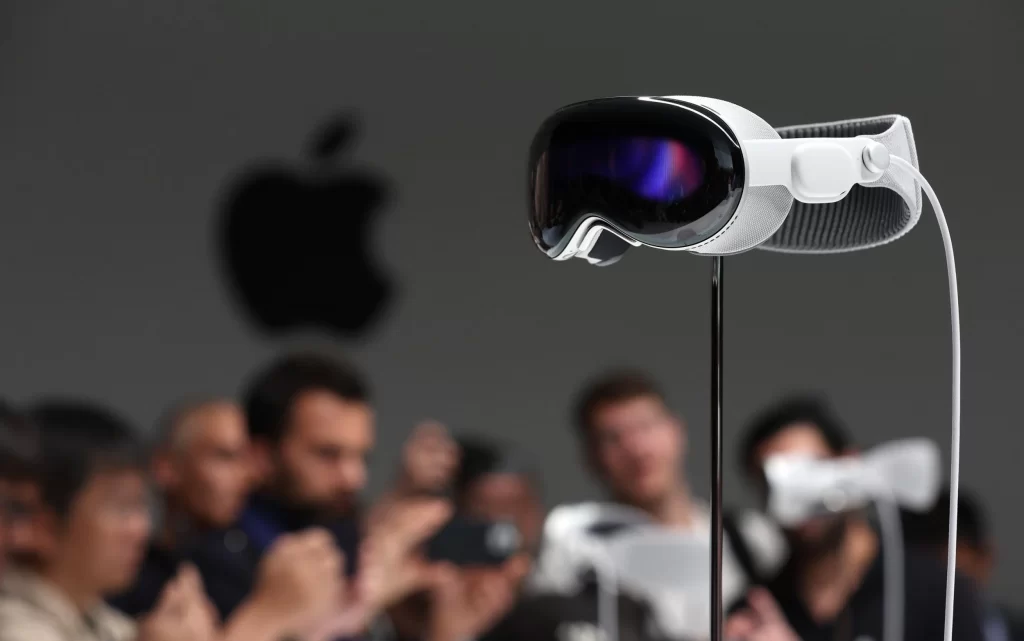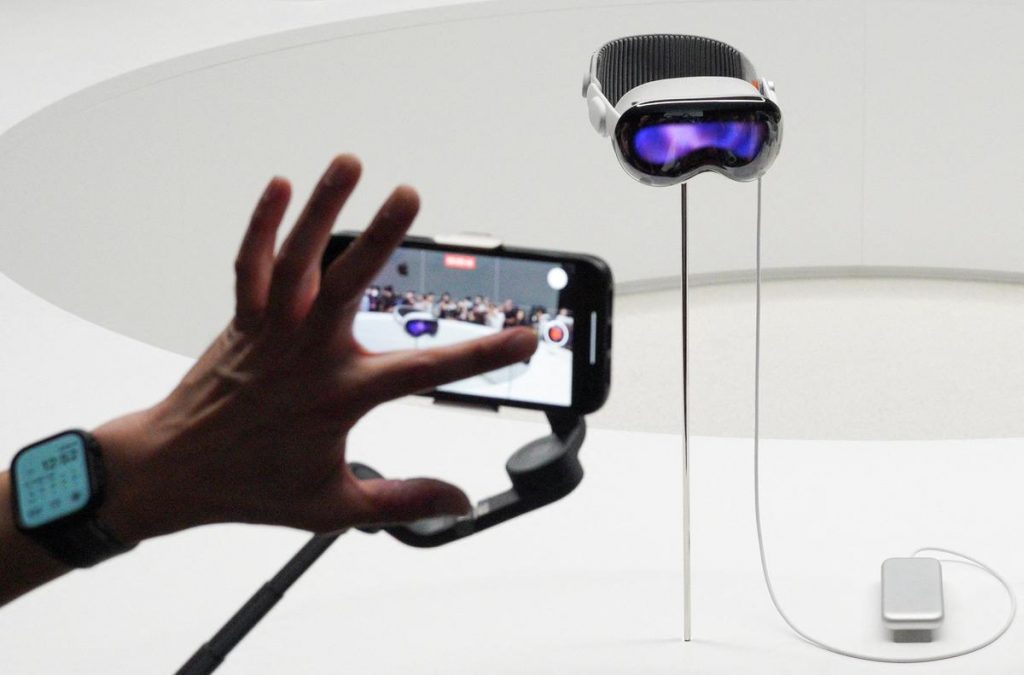Apple Vision Pro headset FAQs
Apple revealed the Vision Pro headset, the company’s first significant new product in a decade, a mixed-reality headset that allows “spatial computing” through the user’s eyes, voice, and hands. The headset is the next chapter in the personal technology space, which hasn’t seen a breakthrough since the iPhone was launched over a decade ago. During its Worldwide Developers Conference Monday, Apple spent much time explaining the headset and what it can do. No matter your first impression of the headset, Vision Pro appears to be more than sci-fi ski goggles. Here are the answers to the most frequently asked questions about the Vision Pro.
- 01
What is the Vision Pro?
The Vision Pro is Apple’s first significant new product category in eight years. It’s a new type of headset that can be controlled using the wearer’s eyes, hands, and voice, a prominent differentiated feature you won’t get on other headsets. “It’s the first Apple product you look through and not at,” Apple CEO Tim Cook said during the annual WWDC, adding that Vision Pro represents “spatial computing” and brings “a new dimension to powerful personal technology.”
- 02
Is Vision Pro heavily leaning on augmented reality?
The Vision Pro is an augmented-reality headset that “seamlessly” blends the real and digital worlds. Nowhere has Apple used the term “mixed reality” and “virtual reality” during the presentation. This might be an intentional move, but if you dig deeper, Apple’s focus with the Vision Pro is more on AR and less on VR.
- 03
Does the Vision Pro look any different from other headsets?
Resembling a pair of ski goggles, the headset features a glass 23-million-pixel screen that covers the upper face. While most other headsets on the market look heavy and bulky, the Vision Pro seems different. It is encased in “aerospace grade alloys,” glass, and fabric, which makes it a high-end headset. Plus, the facial interface is adjustable, which means it should provide a closer, more comfortable fit than other headsets from its competitors. It also contains five sensors, 12 cameras, a 4K display for each eye, and a wearable computer that needs to be cooled with a fan. Although the Vision Pro is pitched as an AR device, it can switch between augmented and complete virtual reality using a dial.
- 04
Can a person with an eye prescription use Apple’s Vision Pro headset?
Yes. Apple has teamed up with Zeiss to create custom optical inserts that magnetically attach to the lenses of people who wear glasses. We highly recommend that people wearing glasses speak to their optician before considering Vision Pro.
- 05
Is there any age requirement to use the Vision Pro?
Yes. Apple recommends users be 13 years and older to use the headset. This means the headset is not intended for kids.
- 06
What can the headset do?
The Vision Pro allows users to consume and create content in a new way in the spaces around them. Users can watch movies, especially in 3-D, with spatial audio as if they were in a cinema hall, view their pictures or videos, and play video games. For example, one key feature of the Vision Pro is the ability to see apps overlaid across real-world surroundings. All they need to flick to scroll through options and tap their fingers together to select something with gestures. During the presentation, Apple showed how users can interact with others when using FaceTime, for example. The company highlighted how users can capture “spatial” 3-D videos and photos using the headset.
- 07
What’s powering Apple’s Vision Pro headset?
The Vision Pro runs on the same M2 processor Apple uses in its Macs. In addition, the headset has a proprietary R1 chip, which allows the device to remain silent and stream images without lag. The R1 also enables EyeSight, a feature that projects realistic graphics of your eyes to those around you while you are wearing the headset, and also allows you to see the person you are speaking with through the headset. This makes the Vision Pro miles ahead of other headsets on the market.
- 08
Does the headset use iOS?
No. The Vision Pro uses custom software called “visionOS,” Apple describes as “the first OS designed for the ground up for spatial computing.” At the architecture level, vision is similar to macOS and iOS but adds a “real-time subsystem” for processing interactive visuals on the Vision Pro. Apple also promises a dedicated App Store for the Vision Pro. Naturally, the apps on the Vision Pro will be tuned for the three-dimensional (3D) interface and free from how they used to behave on the iPhone. visionOS also takes advantage of the headset’s eye tracking and the Optic ID, enabling users to use Apple Pay and autofill passwords as they use the device. Apple said it won’t share that data with anyone without your permission.
- 09
Is the Vision Pro water-resistant?
As of now, Apple has not provided any information on the headset’s ruggedness. We don’t know if the headset has got any water resistance rating.
- 10
How long does the battery last?
The Vision Pro requires an external battery pack, and that lasts for only about 2 hours before you need to recharge. The idea to go with a separate battery indicates Apple wanted to focus on reducing the headset’s weight as much as possible while also getting the perfect fit. This may seem logical, considering headsets like the Quest Pro include batteries that make them heavy and bulky to wear all day.
- 11
When will the Vision Pro be available to buy?
Apple plans to sell the Vision Pro to consumers sometime early next year, meaning the headset will be a 2024 product. Initially, the headset’s retail availability will be limited to the US, but Apple said it will gradually bring the Vision Pro to more countries. So expect the headset to be made available in India only in the middle of next year or late 2024.
- 12
How much does the Vision Pro cost?
You must pay nearly Rs 300,000 to get your hands on the headset. Just for context, Meta’s Quest Pro mixed reality headset costs $1000. Apple is no doubt charging top dollar for the headset, but then the price of the Vision Pro won’t be a barrier for a developer or a content creator.

What it’s like to try Apple’s new Vision Pro headset

On Monday, CUPERTINO, California, June 5 (Reuters) – Apple Inc (AAPL.O) let analysts and media, including Reuters, try its $3,499 Vision Pro headset.
What is immediately apparent is the device is not yet meant for the mass market: a test drive requires a setup session with Apple staff and a quick visit with a vision specialist to ensure the headset fits and functions as intended. And the price tag will likely keep all but the most dedicated Apple fans and business users away.
Instead of starting with a consumer version and working up to a “Pro” model, Apple is starting with the premium tier and hoping to bring prices down as the technology matures, said Carolina Milanesi, an analyst with Creative Strategies.
Apple released the Vision Pro to wrest the nascent headset category away from Meta Platforms Inc (META.O), which has already released several headsets but struggled to break out of a virtual reality market long dominated by video games.
The Vision Pro headset has a “digital crown” similar to an Apple watch crown, which can be tapped and turned to make the display transition fluidly between the real world outside and the virtual world inside. Walking around a room or viewing a 3D film feels natural, as does watch a virtual butterfly settle on the user’s outstretched hand.
The device also glitched at least once during a demonstration to Reuters, requiring Apple staff to reboot and showing that the iPhone maker still has some kinks to iron out.
Here are some key takeaways from the demonstration:
– The natural world and other people are always present. While wearing the device, the default mode is to see the outside world in full color. Even fully immersed in a virtual world, exterior cameras watch for other humans. If another person approaches the user, that person materializes through the virtual world.
– Hollywood will likely take an interest. Apple demonstrated a series of “immersive videos” shot on unique proprietary cameras where the viewer can step inside and look around.
– The sense of place can be startling. In one video, a tightrope walker suspended between two mountains edges toward the viewer, creating an unsettling urge to look down at an intimidating chasm below. At the same time, realism can make mundane details look out of place in a polished production, like a cheap plastic water bottle sitting on the piano during a recording session with a famous singer.
– From the outset, Apple has focused on the business case for Vision Pro, demonstrating how to simultaneously use multiple apps in the headset, which is akin to having several high-resolution displays. It also showed how two users could share and manipulate three-dimensional virtual objects during a conference call. Both functions could be used in the corporate world, where Vision Pro’s price tag would sit on cost centers rather than household budgets.
– Video calls will take some getting used to. Apple showed a FaceTime video call between two people wearing the headset. The experience is similar to a standard video call but uses complicated technology to project an image of the caller, not a conventional face-pointing handset or monitor camera.
– To construct a virtual “persona” of the caller that shows their facial expressions, the system uses pre-loaded pictures combined with data from the Vision Pro’s interior eye-tracking design and exterior hand-tracking cameras. But the net effect is human-but-not-quite, a phenomenon robotics experts call the “uncanny valley” effect, where faces that resemble humans but are slightly off can make users feel uneasy.












